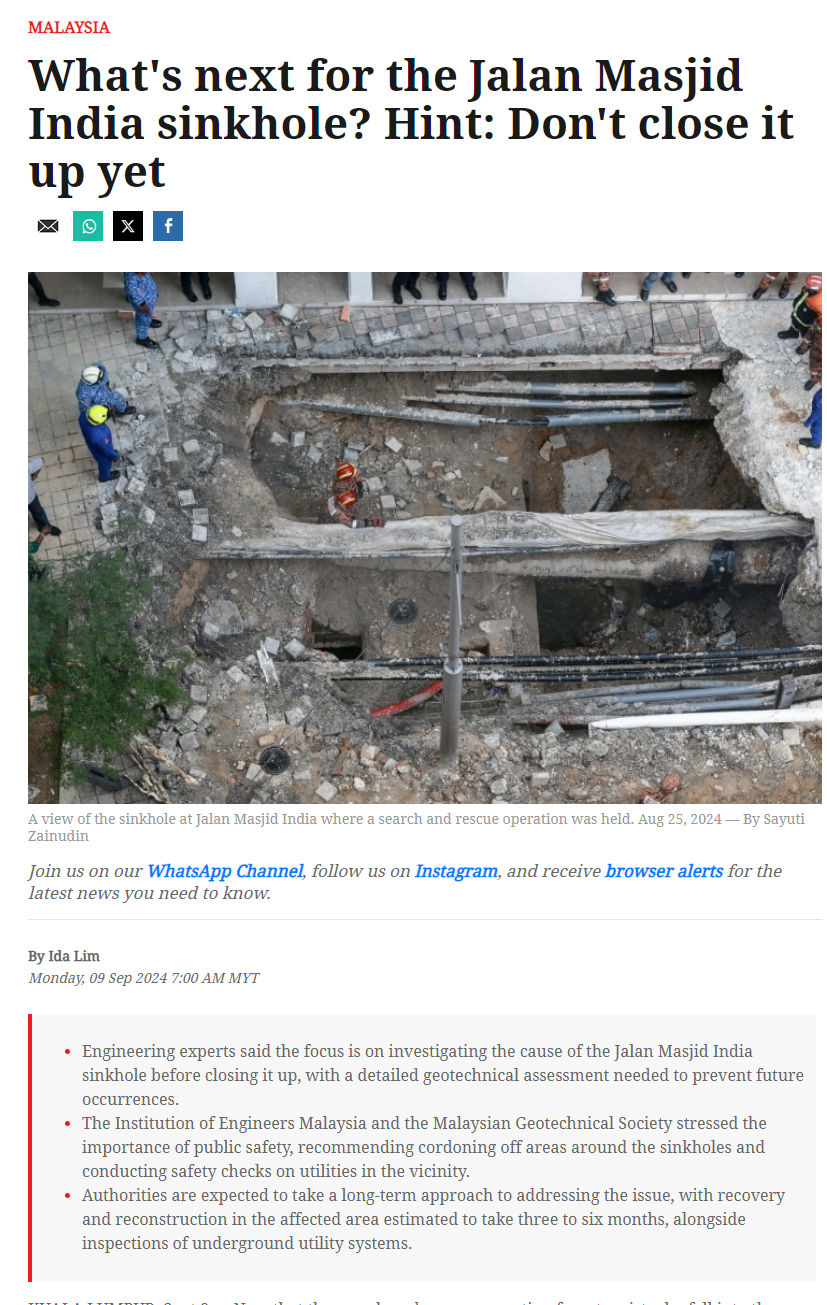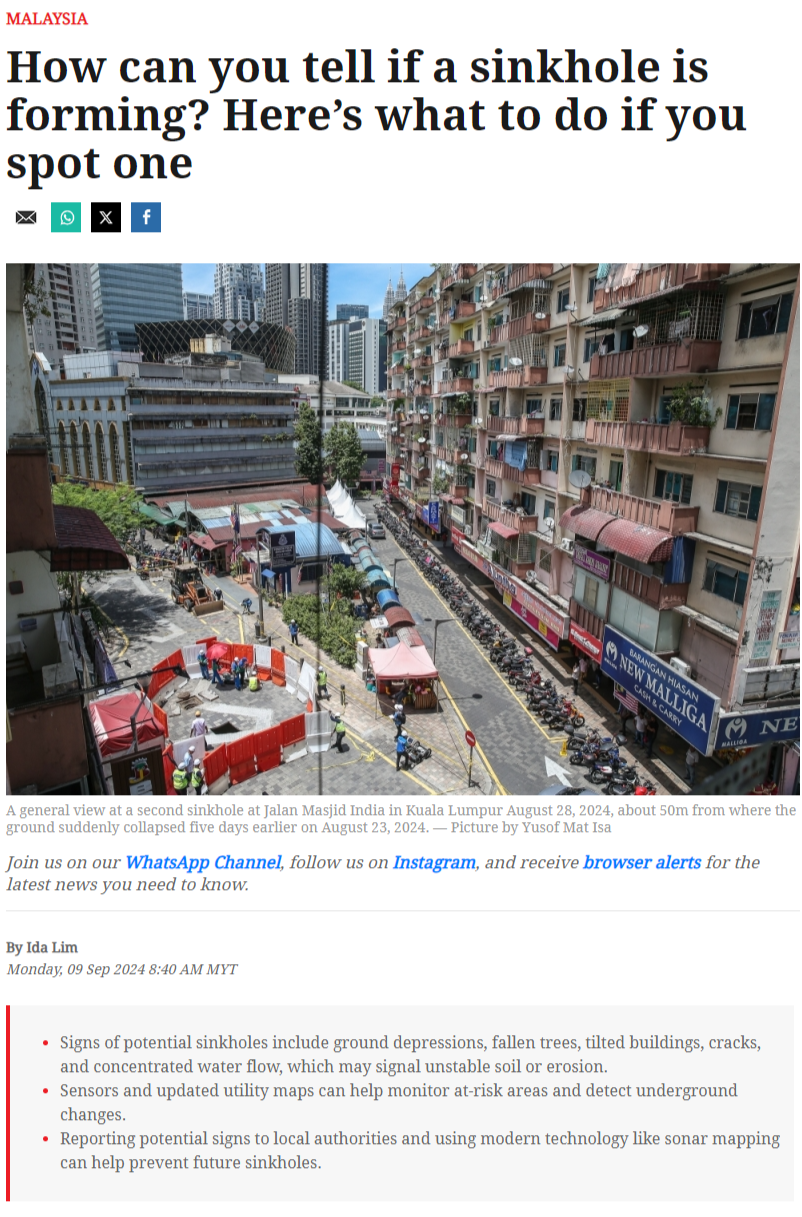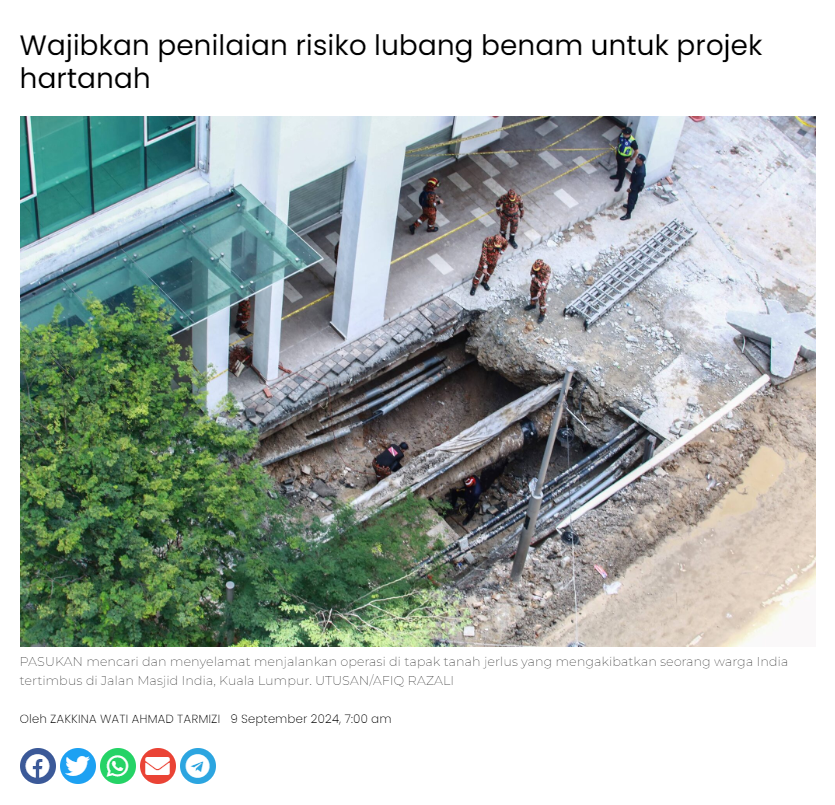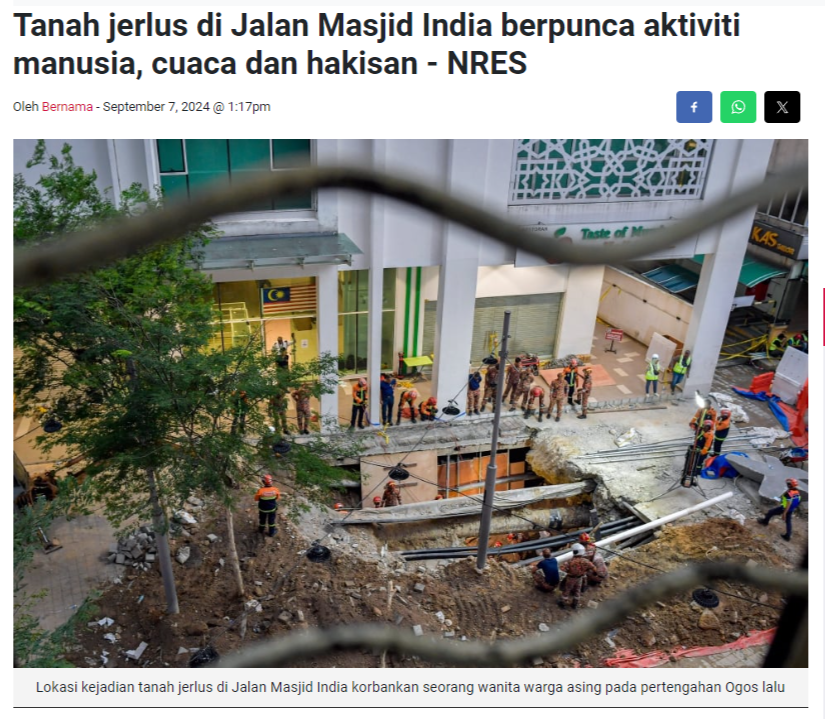
KUALA LUMPUR, Sept 9 — Now that the search and rescue operation for a tourist who fell into the sinkhole at Kuala Lumpur’s Jalan Masjid India has ended and moved to the search and recovery phase, what’s next? Will the cordoned-off sinkhole be closed up now, for example?
Engineering groups which spoke to Malay Mail said that the focus will be on investigating why the sinkhole happened, instead of closing it up immediately.
The Malaysian Geotechnical Society (MGS), which is a professional association for geotechnical engineers with about 200 members and also a part of the Kuala Lumpur City Hall’s (DBKL) task force on the Jalan Masjid India sinkhole, said a detailed investigation is needed first.
“The immediate next step is to conduct a detailed Geotechnical assessment to understand the extent of the sinkhole and the underlying cause. Closing up the sinkhole without addressing the root cause could lead to recurring issues.
“If the sinkhole is a result of a compromised drainage or sewage system, a comprehensive overhaul of these systems may be necessary to ensure the integrity accordingly. DBKL has already set up a Task Force to look into this matter and the Malaysian Geotechnical Society (MGS) is part of this Task Force Team,” the MGS said in an email response to Malay Mail's questions.
The Institution of Engineers Malaysia’s (IEM) president Prof Jeffrey Chiang Choong Luin said the sinkhole at Jalan Masjid India cannot be closed up now, as a thorough investigation has to be carried out there first to examine the structure of the ground underneath and find out why the sinkhole happened.
“One has to be aware that the ground underneath the collapsed pavements has been there for many years, presumably with many laid and over-laid service pipes, utilities, sewerage etc which is currently still serving the community in the vicinity.
“The opened-up sinkhole could be a good starting point for authorities to carry out in-depth investigation on what has transpired, and how such collapsed incidents can be prevented in similar spots nearby. It is still premature for us to make comments without proper investigation carried out yet,” he also told Malay Mail in a recent interview.
Chiang said the authorities will have to take a long-term view on how to resolve this matter and to alleviate the concerns of the public, and that the authorities will be the ones to make the call on the next steps.
“They will be the agency to decide whether to repair and to close up the collapsed sinkhole; or whether the services and utility underground on site need to be overhauled,” he said.
“IEM as an engineering professional institution do have experts among our 50,000 members, and we stand ready to assist the Authority in carrying out investigation and to propose and implement improved system to monitor and to map out hotspots in the KL city areas which are deemed to be of high risk,” he added.
So, which area needs to be cordoned off?
Asked whether there is a need for the nearby shops and area around the sinkhole at Jalan Masjid India to be cordoned off, Chiang said it is “necessary precautionary measure” to cordon off the hazard areas surrounding the sinkholes formed there “to safeguard the nearby shops, owners, workers and shoppers”.
“I think if you are the owner of the shop in the vicinity, your first concern would be personal safety and the wellbeing of other people nearby. The dangers here are that the risk of further sinkholes could occur in another nearby spot. Hence, it makes sense for authorities to take such precautionary measure. Yes, no doubt business operations will be affected, but human lives are so much more precious,” he said.
MGS said “public safety is of utmost importance, and it is prudent to conduct thorough safety checks in the vicinity of the sinkhole of Jalan Masjid India”, adding that the cause of a second sinkhole which appeared near to the first one there “shall also be quickly identified”.
“To be cautious, the area along the alignment of the utilities should be cordoned off for safety checks. While some checks might be conducted without restricting public access, more thorough investigations may require cordoning off the area to prevent any accidental harm to the public or workers,” MGS said, adding that the DBKL taskforce which it is part of will be providing technical recommendations on this matter.
But when asked if this means the cordon could possibly include buildings in the Jalan Masjid India, MGS said: “It is not necessary to include buildings and shops and walkways unless there are clear signs of instability or are deemed at risk.”
Asked whether the cordon or barriers should be around the two sinkholes only or if those would be a starting point, MGS said this would depend on the situation:
“Initially, cordoning off should focus on the areas around the first and second sinkholes to ensure public safety. Depending on the findings, it might be necessary to expand the cordoned area to include wider areas if they are deemed at risk”.
Asked if it would be feasible and doable to eventually widen the safety checks such as to the whole downtown Kuala Lumpur, MGS suggested a targeted approach: “Widening safety checks to the entire downtown Kuala Lumpur may be impractical. However, it would be prudent to identify areas of concern and then perform detailed safety checks on those areas.”
When asked if surrounding areas near Jalan Masjid India might be at risk and how the public would know which area nearby is safe, MGS pointed to the need for the investigation to be completed first: “A thorough investigation shall be carried out to identify the root cause of the issue. Clear communication from authorities will help the public understand the risks and safety measures being implemented by the relevant agencies.”
With the investigation on the Jalan Masjid India sinkhole still going on, MGS advised against speculation: “It is important for the media not to speculate on the causes of such incidents, as this might cause unnecessary chaos and fear among the public.”
MGS said prevention measures can be suggested after the investigation finds out why the sinkhole at Jalan Masjid India happened.
On September 1, national news agency Bernama reported Kuala Lumpur Mayor Datuk Seri Maimunah Mohd Sharif as saying that recovery and reconstruction covering 200 metres of the affected area at Jalan Masjid India is expected to take between three to six months.
She also said there would be checks on the underground utility systems including to inspect for any pipe leakages, while the Department of Minerals and Geoscience would provide detailed technical reports and information on soil stability around the sinkhole.









